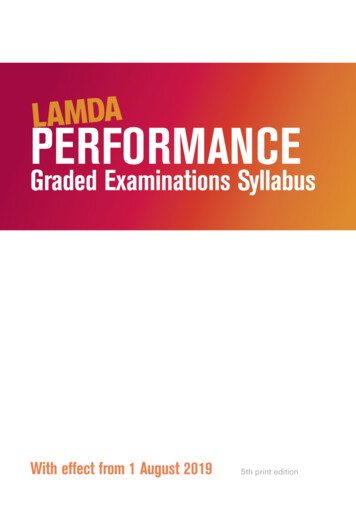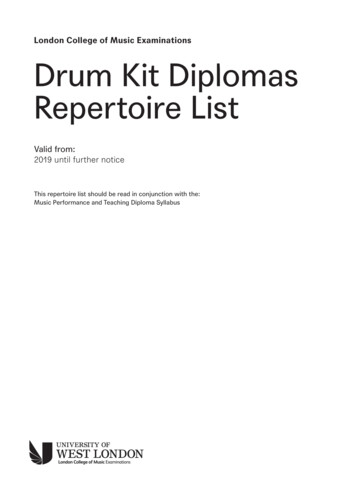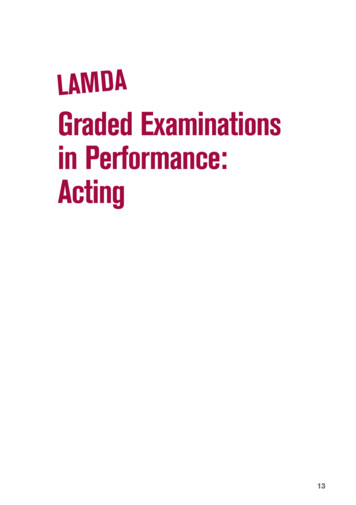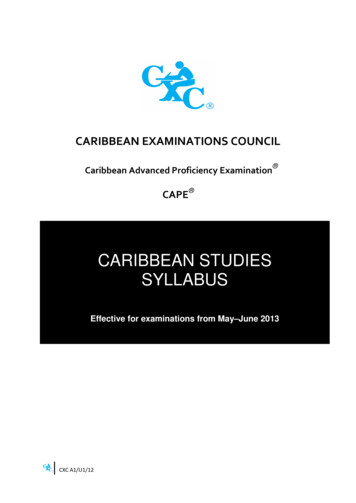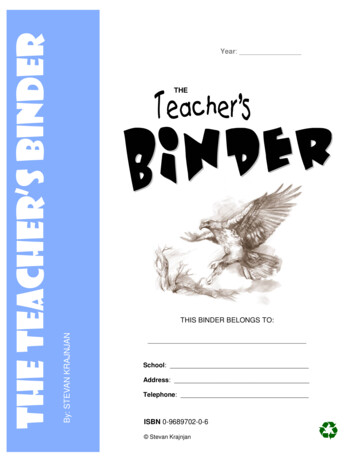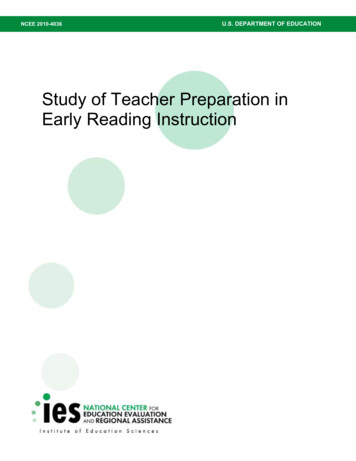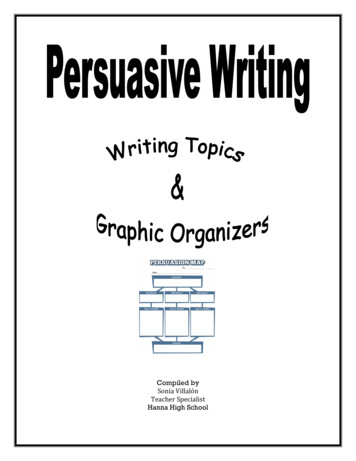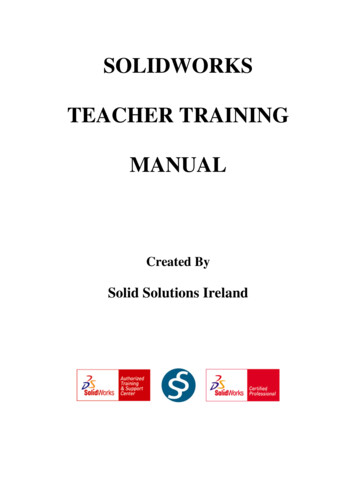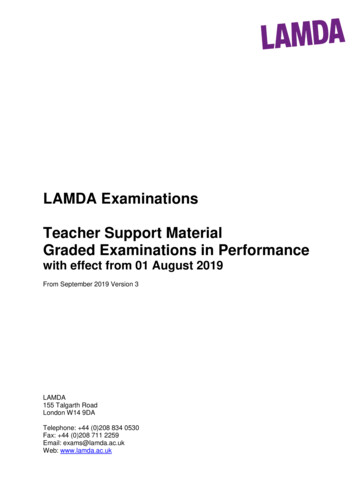
Transcription
LAMDA ExaminationsTeacher Support MaterialGraded Examinations in Performancewith effect from 01 August 2019From September 2019 Version 3LAMDA155 Talgarth RoadLondon W14 9DATelephone: 44 (0)208 834 0530Fax: 44 (0)208 711 2259Email: exams@lamda.ac.ukWeb: www.lamda.ac.uk
Notice to ReaderThis document has been put together to support teachers and Learners who are preparingfor LAMDA Graded Examinations in Performance. It is to be used in conjunction with theLAMDA Graded Examinations in Performance syllabus specification, valid from 1 August2019.LAMDA Teacher Support Material from September 2019 Version 3Graded Examinations in Performance – effective 01 August 20192
ContentsPageLAMDA Graded Examinations in Performance: Acting4Examination StructureCostumeProps/StagingUse of the Performance SpaceFocusSelecting Scenes: General NotesSelecting Scenes: Entry LevelSelecting Scenes: Level 1 (Grades 1, 2 and 3)Selecting Scenes: Level 2 (Grades 4 and 5)Selecting Scenes: Level 3 (Grades 6, 7 and 8)Selecting Scenes: Useful SourcesPost-2000 AuthorsLevel 2 - Grade 5 Knowledge: Reasons for the Choice of StagingLevel 3 - Grade 6 Knowledge: Using the Breath to Support the VoiceLevel 3 - Grade 7 Knowledge: Writer’s Style and Period of WritingLevel 3 - Grade 8 Knowledge: Selecting a Practitioner444445556678991010LAMDA Graded Examinations in Performance: Devising Drama12Examination StructureCostumeProps/StagingUse of the Performance SpaceFocusStructuring a Devised Scene: General NotesImprovisation (Level 3)Using Music/Sound Effects121212121213131313LAMDA Graded Examinations in Performance: Miming14Examination StructureCostumeProps/StagingUse of the Performance SpaceFocusMiming TechniqueStructuring a Mime Scene: General NotesThe Difference Between a Mime and a Mime SceneMiming to MusicMiming a Mammal, Bird or Reptile (Grade 5)Miming in Slow Motion (Grade 6)Commedia dell’Arte (Grade 7)Using a Full Face Mask (Grade 8)Grade 8 Knowledge: Selecting a Practitioner1414141414151515151616161717LAMDA Teacher Support Material from September 2019 Version 3Graded Examinations in Performance – effective 01 August 20193
LAMDA Graded Examinations in Performance: ActingExamination StructureThis Qualification is available at four Levels, in line with the Regulated QualificationsFramework (RQF):Entry Level (Entry 3)Level 1: Grades 1, 2 and 3Level 2: Grades 4 and 5Level 3: Grades 6 (Bronze Medal), Grade 7 (Silver Medal) and Grade 8 (Gold Medal)LAMDA examinations in Acting are offered in the following formats: Solo (one Learner)where the Learner performs alone; Duologue (two Learners) where the Learners perform allscenes together; Combined (two Learners, available at Level 1 and Level 2 only) where theLearners perform one solo scene each and one duologue scene together.Please note that for Duologue and Combined examinations, Learners cannot changepartners in the middle of the examination.CostumeThere is no specific dress code for LAMDA Acting examinations. Full costume is notpermitted, but long practice skirts which help to indicate/suggest period may be worntogether with small costume items such as scarves, hats, shawls, gloves or canes. Clothingand footwear should be suitable for the work presented and comfortable where possible,allowing freedom of movement. The Learner(s) should not go barefoot unless the partdemands it. Nudity is not permitted.Props/StagingHand props are permitted but must be kept to a minimum so as to not overburden theLearner(s).Use of the Performance SpaceThe Learner(s) should try to avoid playing in profile for too long, especially in duologueexaminations, as this masks facial expression.The Learner(s) should try not to place themselves too near the Examiner’s table for theduration of the scene as this limits their overall use of the performance space.FocusThe Learner(s) should ensure that they perform their scene(s) with appropriate focus.When performing a direct address to audience, the Learner(s) should focus on the imaginedwider audience of which the Examiner is a part, and not directly on the Examiner.When performing a duologue scene, both Learners should be focussed within the world oftheir characters and, for each individual, on their duologue partner where appropriate, as theother character in the scene.LAMDA Teacher Support Material from September 2019 Version 3Graded Examinations in Performance – effective 01 August 20194
When a solo Learner performs a monologue with an unseen character present, their focusshould be within the world of their character and on the unseen character where appropriate.When a solo Learner performs a soliloquy or a monologue without an unseen characterpresent, the Learner’s focus should be within the world of their character. Where the Learnershould focus specifically within the world of their character will depend on what the Learnerfeels is appropriate for the scene.Selecting Scenes: General NotesAny published translation of non-English language text is acceptable.The use of accent/dialect is not compulsory; however, the style and intent of the playwrightshould be reflected in the interpretation of a role.The Learner(s) must only play one character in their scene. Where the lines of othercharacters are omitted, you must ensure coherence so that the emotional fluency of thescene is maintained.Scenes which are a direct address to audience should not be focussed solely on theExaminer. The Examiner should be included in a wider imagined audience.When selecting duologue scenes, you should ensure that both Learners have an equalbalance of dialogue, giving them both the opportunity to develop the characters they portray.The editing of published scenes is permitted, providing the coherence and fluency of thescene is maintained. Please note that you are not permitted to add your own dialogue to ascene, unless you are adapting it from a published novel (For Entry Level t Grade 5 only)The Learner(s) should bring legible copies of all selections into the examination for theExaminer. This is for prompting purposes, if it is required. Please note that the Examinermay keep copies of the Learners pieces for results processing purposes.Selecting Scenes: Entry LevelFor Entry Level Acting examinations the Learner(s) must perform one Own Choice scene.The scene must be selected from a published play or screenplay or a published collection ofsolo/duologue scenes or be adapted from the dialogue of a published novel. It must not beset in the LAMDA Acting Anthology – Volume 4.The language of the scene should be accessible to the Learner, with vocabulary andsentence structure that conveys meaning clearly.Selecting Scenes: Level 1 (Grades 1, 2 and 3)For Level 1 Acting examinations the Learner(s) must perform two scenes: A Set Piece whichhas been selected from the appropriate section of the LAMDA Acting Anthology – Volume 4and one scene of their Own Choice.LAMDA Teacher Support Material from September 2019 Version 3Graded Examinations in Performance – effective 01 August 20195
The Own Choice scene must be selected from a published play or screenplay or a publishedcollection of solo/duologue scenes or be adapted from the dialogue of a published novel. Itmust not be set in the LAMDA Acting Anthology – Volume 4.The language of the Own Choice scene should contain a variety of expressive vocabularyand offer some opportunity for character development.You should try to ensure that the Own Choice scene differs from the set scene in theme,setting, character and/or mood, enabling the Learner(s) to display some contrast.Selecting Scenes: Level 2 (Grades 4 and 5)For Level 2 Acting examinations the Learner(s) must perform two scenes: A Set Piece whichhas been selected from the appropriate section of the LAMDA Acting Anthology – Volume 4and one scene of their Own Choice.The Own Choice scene must be selected from a published play or screenplay or a publishedcollection of solo/duologue scenes or be adapted from the dialogue of a published novel. Itmust not be set in the LAMDA Acting Anthology – Volume 4.The language of the Own Choice scene should contain some subtlety in vocabulary so thatthere are opportunities for character development.You should try to ensure that the Own Choice scene differs from the set scene in theme,setting, character and/or mood, enabling the Learner(s) to display some contrast.Selecting Scenes: Level 3 (Grades 6, 7 and 8)For Grade 6 the Learner(s) must perform two scenes. The first scene must be selected froma play written during one of the following periods: Ancient Greek and Roman (500BC – 4BC) Elizabethan and Jacobean (1558-1625) Restoration and Post-Restoration (1626 – 1799) 1800 to 2000The second scene must be selected from a published play, television or film screenplaypublished post-2000.For Grade 7 and Grade 8 the Learner(s) must perform three scenes. The first scene mustbe selected from a play written during one of the following periods: Ancient Greek and Roman (500BC – 4BC) Elizabethan and Jacobean (1558-1625) Restoration and Post-Restoration (1626 – 1799)The second scene must be selected from a play written during the period 1800 to 2000. Thethird scene must be selected from a published play, television or film screenplay publishedpost-2000.Scenes from television shows and serials are not permitted. The scene must also not be setin the current LAMDA Acting Anthology – Volume 4.Scenes taken from the post-2000 period must be published on or after 1 January 2001.LAMDA Teacher Support Material from September 2019 Version 3Graded Examinations in Performance – effective 01 August 20196
If a non-English language text is selected for the Ancient Greek and Roman period,Elizabethan and Jacobean period or Restoration and Post-Restoration period, translations ofthe original play into English must be used –adaptations or new-versions are not allowed.For example, Jean Anouilh’s adaptation of Antigone would not be an appropriate choice forthe Ancient Greek and Roman period as it is not a translation of the original, but a playinspired by the original text and set in a different time period.At this Level, the Learner(s) are required to study the plays from which their scenes havebeen taken in preparation for the Knowledge element of the exam. As a result, stand-alonemonologue and duologue scenes and sketches are not appropriate for example TalkingHeads by Alan Bennett would not be appropriate to use since this would not allow theLearner(s) to talk about the characters context within the play as a whole. They also do notallow the Learner(s) the opportunity to understand their character’s role within the context ofthe play as a whole, which is important at this Level. Scenes from one act plays and playsconsisting of a series of linked monologues/duologues are permitted, providing there isenough material in the play to enable the Learner(s) to fulfil the Knowledge requirements ofthe exam, for example Confusions by Alan Bennett.Selected scenes should differ in style, theme, setting, character, mood and/or period toenable the Learner(s) to display range and ability.Selected scenes should enable the Learner(s) to engage with complex emotions anduniversal themes.The content and language of the scenes should be technically challenging in terms of vocalrange and characterisation.It is important to remember that a Learner’s speech, movement, gesture and body languageshould reflect the time in which the scene is set.Selecting Scenes: Useful SourcesIt is a good idea, when selecting own choice scenes, to put together a portfolio of pieces thatyou can use over time with different Learners and at different grades. To put together aportfolio of own choice scenes, consider the following: progression between gradessuitability for different age groupsvariety and balance of characters, for example boys, girls, animalsvariety of situationsappropriate lengthappropriate use of languagevariety of periodequal balance and contrast between characters in duologue scenes.If you are adapting an own choice scene from a published novel (suitable for Entry Level,Level 1 and Level 2 exams only), here are some handy hints to remember: look at the overall shape of the scene; a scene has to have a strong beginning and afirm ending with a clear journey in-betweenLAMDA Teacher Support Material from September 2019 Version 3Graded Examinations in Performance – effective 01 August 20197
dialogue can be lifted from text but thoughts can also be turned into dialogueproviding the style of writing is sustainedcharacters should be clearwhen adapting duologue scenes, ensure that both Learners have an equal balanceof dialogue, giving them both the opportunity to develop the characters they portraythink about the stage directions which will be included in the sceneit is important to always consider the background context leading up to the scene.LAMDA offer the following publications which are useful for sourcing own choice scenes:LAMDA Acting Anthology – Volume 3 (suitable for Entry Level, Level 1 and Level 2)Monologues for Young Actors (suitable for Entry Level, Level 1 and Level 2)These publications are available to purchase through LAMDA’s online shop:www.lamda.ac.uk/store/shop/publicationsOther useful sources for Own Choice scenes are:Samuel French theatre bookshop in London: http://www.samuelfrench-london.co.ukDramatic Lines Publishers: http://www.dramaticlines.co.ukOberon Books: http://www.oberonbooks.comPost-2000 Playwrights/AuthorsThere are an abundance of playwrights and authors who have had work published on orfrom 01 January 2001. Below is a non-exhaustive list of authors whose work has beenpublished post-2000, and who’s plays might be appropriate for Learners taking Grade 6, 7and 8 Examinations.Please note that where a playwright/author has had work published prior to 01 January2001, there will be an asterisk (*) next to it. It is advised that you check the publication of theplay selected, before allowing a Learner to begin preparing this piece for Examination.Snoo (Andrew James)Wilson*Howard Brenton*Helen Edmunsdon*David Hare*Samuel Adamson*Deborah BruceJesse EisenbergDavid Harrower*Stephen Adly GuirgisMoira Buffini*David FarrMatt HartleyBola AgbajeJez Butterworth*Michael Frayn*Jonathan Harvey*Davey AndersonJim Cartwright*Peter Gill*Ella HicksonAlan Ayckbourn*Katherine ChandlerJohn Godber*Craig HigginsonAnnie BarkerCaryl Churchill*Michael Gow*Sam HolcroftMike BartlettRyan Craig*James GrahamCharlene JamesRichard Bean*Tim CrouchSimon Gray*Catherine Johnson*Alan Bennett*Sarah Daniels*Kirsten GreenidgeCharlotte Jones*Helen Blakeman*April de Angelis*David Greig*Cush JumboAndrew BovellClean BreakCollections*Nick Dear*Tanika Gupta*David K.O’HaraDavid Edgar*Ursula Rani Sarma*Kate TempestLAMDA Teacher Support Material from September 2019 Version 3Graded Examinations in Performance – effective 01 August 20198
Dennis Kelly*Glyn MaxwellMark Ravenhill*Finn KennedyMartin McDonagh*Anya ReissJack ThorneCatherineTrieschmannAyub Khan Din*Alistair McDowallJohn Retallack*Debbie Tucker GreenRory KinnearLisa McGeeLaura Wade*Lucy KirkwoodPeter Morgan*Neil LaBute*Rory MullarkeyPhilip iver LansleyRona Munro*Shelley Silas*Bryony Lavery*Anthony NeilsonPenelope SkinnerEnda Walsh*TimberlakeWertenbaker*Christopher WilliamHill*Nick LeatherRichard Nelson*Al SmithNigel Williams*Michael LesslieEugene O’BrienRobin Soans*Roy Williams*Nell LeyshonGary OwenNick Stafford*August Wilson*Liz Lochhead*Joe Penhall*Polly StenhamIsabel Wright*John Logan*Winsome Pinnock*Simon Stephens*Nicholas Wright*Doug Lucie*Evan PlaceyShelagh Stephenson*Kate TempestSharman MacdonaldFrances PoetDarja Stocker*Sabrina MahfouzLucy PrebbleMeera Syal*Douglas MaxwellKatori HallStephen KaramNaomi WallaceLevel 2 - Grade 5 Knowledge: Reasons for the Choice of StagingFor the Knowledge section of Grade 5 Acting examinations the Learner(s) must discuss thereasons for the chosen staging in each scene, using the technical terminology of the workingstage areas. In order to answer this question, the Learner(s) should be able to identify whatstaging they have used for each scene, and the rationale for choosing to stage the scenes inthis particular way. For example, if their choice of staging related to the mood of the scene,to the character's feelings and their situation, or to the character's movement (or lackthereof). Answers should also consider whether there is another character present in thescene (this could be an unseen character or a Learner's Duologue partner) and theLearner's awareness of their imagined audience. To confirm, it is acceptable for a Learner touse a scene that requires only simple staging, as long as they can discuss not just whatstaging has been used but the rationale behind their choices.Staging should not be confused with the character’s movement. Staging is the positioning ofthe performance within the space provided. For example, the scene could be performedupstage, downstage or centre stage, or the staging could vary throughout the performance.It is not a requirement to have a stage set, such as tables, chairs or other items, in order todiscuss staging.Level 3 – Grade 6 Knowledge: Using the Breath to Support the VoiceFor the knowledge section of Grade 6 Acting examinations, the Learner(s) must explain thebreathing techniques used to support the voice in each scene performed.LAMDA Teacher Support Material from September 2019 Version 3Graded Examinations in Performance – effective 01 August 20199
The breathing techniques will be individual to the scenes selected for the Examination,however, there may of course be some similarities in how the Learner(s) used their breathacross both pieces.Learners should focus on what techniques they employed in order for the speech to bedelivered which demonstrates their interpretation, ensuring that they could both be heard,and understood.It is worth considering the differences in breathing techniques required for different emotionaland contextual situations.LAMDA currently publish Knowledge Matters: Volume 3 which provides further detail onusing the breath to support the voice. This is available to purchase through LAMDA’s onlineshop: www.lamda.ac.uk/store/shop/publicationsLevel 3 - Grade 7 Knowledge: Writer’s Style and Period of WritingFor the Knowledge section of Grade 7 Acting examinations, the Learner(s) must discuss thewriting style, and period in which the author of one of the performed scenes was writing(one author will be selected by the Examiner at the time of the examination).The writer’s style of writing is how the writer's thoughts are expressed in literary composition,the specific characteristics of the scene selected and the play that it has been taken from, plusthe characteristics of any other work by the same writer (if appropriate). This would includechoice of words, syntax and genre.The writer’s period of writing is the period in which the writer was writing, looking specifically atthe style of writing and key literary movements of the period as a whole, and how the writer beingdiscussed fits into this. For example, was their style of writing experimental or innovative for theperiod and/or was it in keeping with other playwrights of the time?Level 3 - Grade 8 Knowledge: Selecting a PractitionerFor the Knowledge section of Grade 8 Acting examinations, the Learner(s) must discuss thekey principles and influences in the process of acting for one of the following practitioners:Constantin Stanislavski (1863-1938)Stanislavski was a Russian actor and theatre director.Bertolt Brecht (1898-1956)Brecht was a German playwright.Jerzy Grotowski (1933-1999)Jerzy Grotowski was a Polish theatre director.Katie Mitchell (1964 - )Katie Mitchell is an English theatre director.Kneehigh (Founded 1980)Kneehigh are a theatre company based in Cornwall, England.Antonin Artaud (1896-1948)Antonin Artaud was a French dramatist, poet, essayist, actor and theatre directorLAMDA Teacher Support Material from September 2019 Version 3Graded Examinations in Performance – effective 01 August 201910
Joan Littlewood (1914-2002)Joan Littlewood was an English theatre director.LAMDA Teacher Support Material from September 2019 Version 3Graded Examinations in Performance – effective 01 August 201911
LAMDA Graded Examinations in Performance: Devising DramaExamination StructureThese Qualifications are available at four Levels, in line with the Regulated QualificationsFramework (RQF):Entry Level (Entry 3)Level 1: Grades 1, 2 and 3Level 2: Grades 4 and 5Level 3: Grades 6, Grade 7 and Grade 8LAMDA examinations in Devising Drama are offered in the following formats: Solo (oneLearner) where the Learner performs alone; Duologue (two Learners) where the Learnersperform all scenes together.Please note that for Duologue examinations, Learners cannot change partners in the middleof the examination.CostumeThere is no specific dress code for LAMDA Devising Drama examinations. Full costume isnot permitted, but long practice skirts which help to indicate/suggest period may be worntogether with small costume items such as scarves, hats, shawls, gloves or canes. Clothingand footwear should be suitable for the work presented and comfortable where possible,allowing freedom of movement. The Learner(s) should not go barefoot unless the partdemands it. Nudity is not permitted.Props/StagingHand props are permitted but must be kept to a minimum so as to not overburden theLearner(s). Stage sets should not be over complicated as only a small amount of time isavailable in the examination for setting up scenes.Use of the Performance SpaceThe Learner(s) should try to avoid playing in profile for too long, especially in duologueexaminations, as this masks facial expression.The Learner(s) should try not to place themselves too near the Examiner’s table for theduration of the scene as this limits their overall use of the performance space.FocusThe Learner(s) should ensure that they perform their scene(s) with appropriate focus.When performing a direct address to audience, the Learner(s) should focus on the imaginedwider audience of which the Examiner is a part, and not directly on the Examiner.When performing a duologue scene, both Learners should be focussed within the world oftheir characters and, for each individual, on their duologue partner where appropriate, as theother character in the scene.LAMDA Teacher Support Material from September 2019 Version 3Graded Examinations in Performance – effective 01 August 201912
When a solo Learner performs a monologue with an unseen character present, their focusshould be within the world of their character and on the unseen character where appropriate.When a solo Learner performs a soliloquy or a monologue without an unseen characterpresent, the Learner’s focus should be within the world of their character. Where the Learnershould focus specifically within the world of their character will depend on what the Learnerfeels is appropriate for the scene.Structuring a Devised Scene: General NotesIt is very important that all devised scenes have a clear structure. There should be a strongbeginning, middle and end. There should be a clear line of development throughout thescene towards a climax and individual characters within it should be well defined.If the scene uses a title or an object as a stimulus, the link should not be tenuous. Thestimulus must play an important part in the development of the scene.In duologue scenes it is important that both devised characters have roles that are equallybalanced.Improvisation (Level 3)At Level 3, the Learner(s) are required to present an improvised scene based on a wordstimulus provided by the Examiner at the time of the examination. The Learner(s) will begiven one minute to prepare the scene prior to its performance. Word stimuli will consist ofobjects at Grade 6, articles of clothing at Grade 7 and abstract titles at Grade 8.Using Music/Sound EffectsMusic and/or sound effects are optional to use. The Learner(s) must provide their own soundequipment for use in the examination room. This must be operated by the Learner; atechnician is not permitted in the examining room.LAMDA Teacher Support Material from September 2019 Version 3Graded Examinations in Performance – effective 01 August 201913
LAMDA Graded Examinations in Performance: MimingExamination StructureThis Qualification is available at four Levels, in line with the Regulated QualificationsFramework (RQF):Entry Level (Entry 3)Level 1: Grades 1, 2 and 3Level 2: Grades 4 and Level 3: Grades 6, Grade 7 and Grade 8LAMDA examinations in Miming are offered in the following formats: Solo (one Learner)where the Learner performs alone; Duologue (two Learners) where the Learners performmimes individually and mime scenes together.Please note that for Duologue examinations, Learners cannot change partners in the middleof the examination.CostumeThere is no specific dress code for LAMDA Miming examinations. It is recommended that theLearner(s) wear appropriate footwear and clothing that allows ease of movement. Nudity isnot permitted.Props/StagingProps are not permitted for use in Miming examinations. However, tables and chairs arepermitted for the purposes of staging a mime or mime scene.Use of the Performance SpaceThe Learner(s) should try to avoid playing in profile for too long, especially in duologueexaminations when they are performing a mime scene, as this masks facial expression.The Learner(s) should try not to place themselves too near the Examiner’s table for theduration of the mime/mime scene as this limits their overall use of the performance space.FocusThe Learner(s) should ensure that they perform their scene(s) with appropriate focus.When performing a direct address to audience, the Learner(s) should focus on the imaginedwider audience of which the Examiner is a part, and not directly on the Examiner.When performing a duologue scene, both Learners should be focussed within the world oftheir characters and, for each individual, on their duologue partner where appropriate, as theother character in the scene.LAMDA Teacher Support Material from September 2019 Version 3Graded Examinations in Performance – effective 01 August 201914
Miming TechniqueWords must not be mouthed by the Learner(s) in their mimes/mime scenes as this detractsfrom the importance of the movement alone. A mime/mime scene should incorporate thefollowing technical skills: clear and accurate movementscontrolled and coordinated movementsexpressive facial reaction.Specific requirements on Miming technique will be detailed in the Assessment Criteria forTechnique at each grade.Structuring a Mime Scene: General NotesThe Learner(s) should ensure that their mime scenes are clearly structured. Mime scenesshould demonstrate the following: a well-defined storyline, with a beginning, middle and endinvolvement with the character(s), place and situationan understanding of the place and period in which the characters live (Level 3).Mime often has to be presented with a physicality that is ‘larger than life’ in order to make thesimplest of actions clear to an audience using a vocabulary consisting of only gesture andmovement.The Difference Between a Mime and a Mime SceneA mime is a concentrated moment showing the mood and movement of one particularactivity. At its simplest it could be ‘eating a banana’ or ‘walking across pebbles’. It caninvolve the creation of a character, but this character must be focused on one occupation.An animal can be depicted, showing its shape and natural moves. It is always a solo piece.Marcel Marceau called such mimes his ‘exercises’ but in performance, for example TheCage or The Mask Maker, they kept his audience enthralled.A mime scene is a series of activities that create a piece of drama. This can range from asimple episode, for example looking at the exhibits in a museum, to a more complicatedscene in which museum exhibits come to life. It can show conflict between characters. It maybe abstract or tell a story, be comic or poignant. A mime scene needs to use spacetheatrically to portray the illusion it is creating. The scene should take the audience on ajourney.Miming to MusicMusic can be a most helpful introduction to mime. It can inspire the creation of a situation,support a characterisation and sustain a complete performance. Rhythms and evocativeemotional qualities can guide the Learner(s) away from self-consciousness and help them tofind movement and create moods with greater confidence.Try to use music and sound effects with mime to create a satisfying whole. Strong rhythmscan be an effective accompaniment to a comic situation. Lyrical music can support and helpdevelop an abstract mime. The performer must know their music perfectly so that everyLAMDA Teacher Support Material from September 2019 Version 3Graded Examinations in Performance – effective 01 August 201915
change of emphasis supports the movement. In order for a piece to be a complete blend oftiming and sensitivity, the Learner(s) need to build each movement in response to the music.If the Learner(s) have developed a character and possible situation idea then it may beinteresting to play some different pieces of music and ask the Learner(s) to choose whichpiece might best fit the idea. Alternatively, you may propose a piece of music and see whatthis evokes in the Learner’(s) minds. For example, Walking to Regios, a track by IsaacHayes, provides the inspiration for a devious character. This piece of music clearly takes thatcharacter and their actions across a cityscape – it is furtive, searching and it concludes witha meeting and possible conflict.Film music such as the soundtracks for Chocolat or Amelie, and classical music such asHolst’s Planets Suite, can be useful.Miming a Mammal, Bird or Reptile (Grade 5)At Grade 5, the Learner(s) are required to perform a prepared mime depicting a mammal,bird or
Level 2 - Grade 5 Knowledge: Reasons for the Choice of Staging 9 Level 3 - Grade 6 Knowledge: Using the Breath to Support the Voice 9 Level 3 - Grade 7 Knowledge: Writer’s Style and Period of Writing 10 Level 3 - Grade
